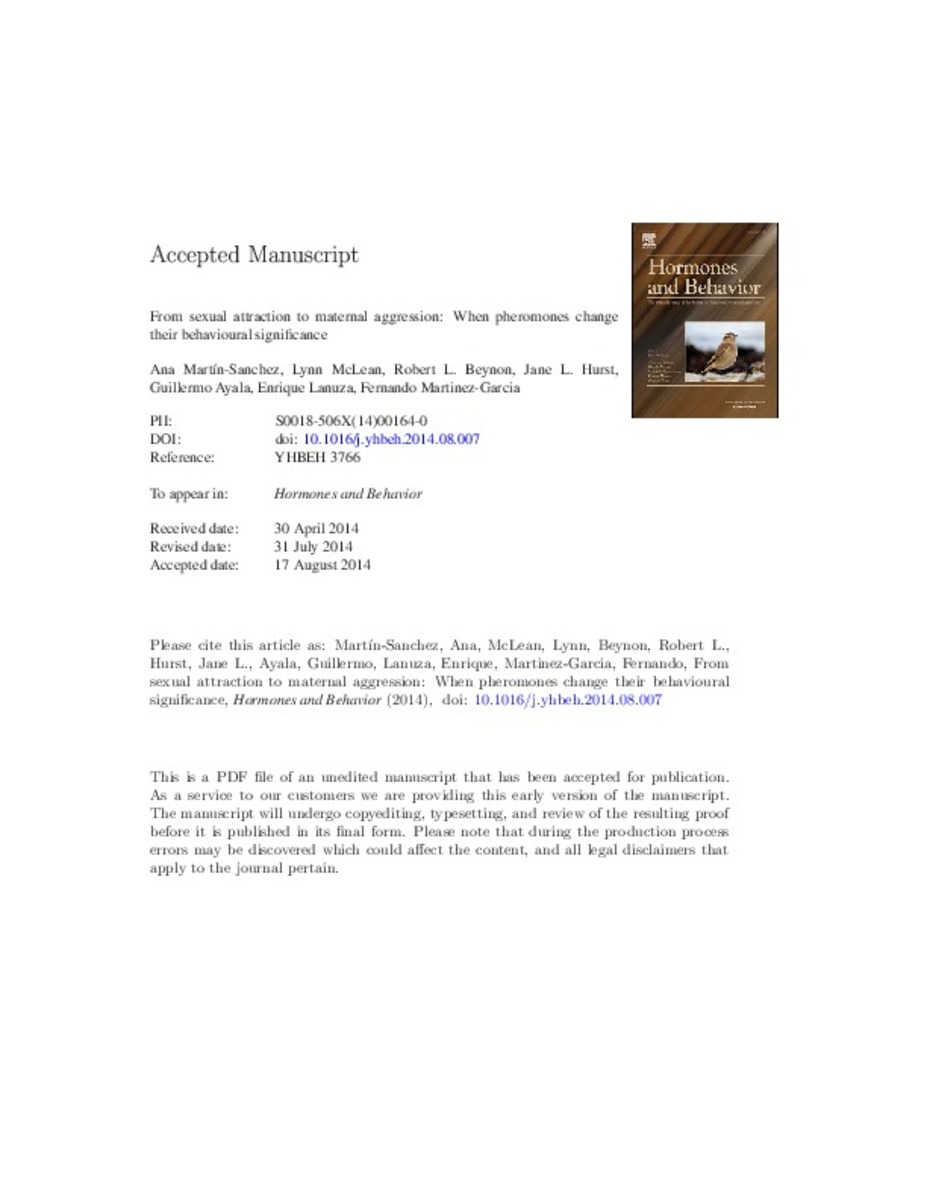Mostrar el registro sencillo del ítem
From sexual attraction to maternal aggression: When pheromones change their behavioural significance
| dc.contributor.author | Martín Sánchez, Ana | |
| dc.contributor.author | McLean, Lynn | |
| dc.contributor.author | Beynon, Robert J. | |
| dc.contributor.author | Hurst, Jane L. | |
| dc.contributor.author | Ayala Gallego, Guillermo | |
| dc.contributor.author | Lanuza, Enrique | |
| dc.contributor.author | Martinez-Garcia, Fernando | |
| dc.date.accessioned | 2016-02-11T15:01:33Z | |
| dc.date.available | 2016-02-11T15:01:33Z | |
| dc.date.issued | 2015-02 | |
| dc.identifier.citation | MARTÍN-SÁNCHEZ, Ana, et al. From sexual attraction to maternal aggression: when pheromones change their behavioural significance. Hormones and behavior, 2015, vol. 68, p. 65-76. | ca_CA |
| dc.identifier.uri | http://hdl.handle.net/10234/149589 | |
| dc.description.abstract | This article is part of a Special Issue “Chemosignals and Reproduction”. This paper reviews the role of chemosignals in the socio-sexual interactions of female mice, and reports two experiments testing the role of pup-derived chemosignals and the male sexual pheromone darcin in inducing and promoting maternal aggression. Female mice are attracted to urine-borne male pheromones. Volatile and non-volatile urine fractions have been proposed to contain olfactory and vomeronasal pheromones. In particular, the male-specific major urinary protein (MUP) MUP20, darcin, has been shown to be rewarding and attractive to females. Non-urinary male chemosignals, such as the lacrimal protein ESP1, promote lordosis in female mice, but its attractive properties are still to be tested. There is evidence indicating that ESP1 and MUPs are detected by vomeronasal type 2 receptors (V2R). When a female mouse becomes pregnant, she undergoes dramatic changes in her physiology and behaviour. She builds a nest for her pups and takes care of them. Dams also defend the nest against conspecific intruders, attacking especially gonadally intact males. Maternal behaviour is dependent on a functional olfactory system, thus suggesting a role of chemosignals in the development of maternal behaviour. Our first experiment demonstrates, however, that pup chemosignals are not sufficient to induce maternal aggression in virgin females. In addition, it is known that vomeronasal stimuli are needed for maternal aggression. Since MUPs (and other molecules) are able to promote intermale aggression, in our second experiment we test if the attractive MUP darcin also promotes attacks on castrated male intruders by lactating dams. Our findings demonstrate that the same chemosignal, darcin, promotes attraction or aggression according to female reproductive state | ca_CA |
| dc.format.extent | 42 p. | ca_CA |
| dc.format.mimetype | application/pdf | ca_CA |
| dc.language.iso | eng | ca_CA |
| dc.publisher | Elsevier | ca_CA |
| dc.relation.isPartOf | Hormones and behavior, 2015, vol. 68 | ca_CA |
| dc.rights | Attribution-NonCommercial-NoDerivs 4.0 Spain | * |
| dc.rights.uri | http://creativecommons.org/licenses/by-nc-nd/4.0/ | * |
| dc.subject | Mouse | ca_CA |
| dc.subject | Major urinary proteins | ca_CA |
| dc.subject | Darcin | ca_CA |
| dc.subject | Socio-sexual behaviour | ca_CA |
| dc.subject | Vomeronasal | ca_CA |
| dc.subject | Olfactory | ca_CA |
| dc.title | From sexual attraction to maternal aggression: When pheromones change their behavioural significance | ca_CA |
| dc.type | info:eu-repo/semantics/article | ca_CA |
| dc.identifier.doi | http://dx.doi.org/10.1016/j.yhbeh.2014.08.007 | |
| dc.rights.accessRights | info:eu-repo/semantics/openAccess | ca_CA |
| dc.relation.publisherVersion | http://www.sciencedirect.com/science/article/pii/S0018506X14001640 | ca_CA |
| dc.edition | Postprint | ca_CA |
| dc.type.version | info:eu-repo/semantics/publishedVersion |
Ficheros en el ítem
Este ítem aparece en la(s) siguiente(s) colección(ones)
-
MED_Articles [637]
Articles de publicacions periòdiques








